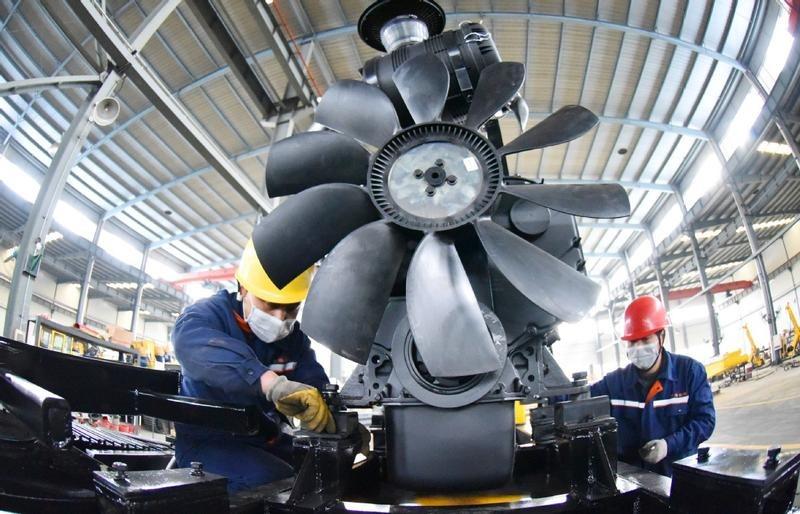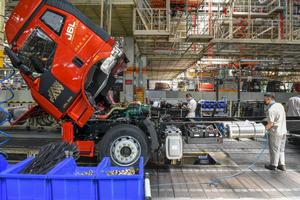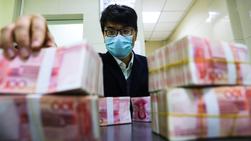 In this undated photo, workers assemble an industrial turbine at a factory in the Haizhou Economic Development Zone in Lianyungang, Jiangsu province. (PHOTO / FOR CHINA DAILY)
In this undated photo, workers assemble an industrial turbine at a factory in the Haizhou Economic Development Zone in Lianyungang, Jiangsu province. (PHOTO / FOR CHINA DAILY)
BEIJING -China's economy bounced back to growth in the second quarter this year as the country gradually resumed work and production after having the COVID-19 epidemic effectively contained, official data showed Thursday.
In the first half of this year, the country's GDP stood at 45.66 trillion yuan (about US$6.53 trillion) amid COVID-19 impact, down 1.6 percent year on year, said the NBS
The country's gross domestic product (GDP) expanded 3.2 percent year on year in the second quarter, according to data from the National Bureau of Statistics (NBS).
In the first half of this year, the country's GDP stood at 45.66 trillion yuan (about US$6.53 trillion) amid COVID-19 impact, down 1.6 percent year on year, said the NBS.
Industrial output up 4.4%
It said China's value-added industrial output, an important economic indicator, went up 4.4 percent year on year in the second quarter as factories stepped up production amid COVID-19 control.
In June alone, industrial output went up 4.8 percent year on year, faster than the 4.4-percent expansion seen in May and marking the third consecutive month of growth, the NBS data showed.
ALSO READ: Xi voices confidence in China's economy, vows wider opening-up
In the first half of the year, industrial output fell 1.3 percent, dragged down by the 8.4-percent slump in the first quarter as the novel coronavirus outbreak disputed economic activities during the period.
Last month, output by the industries in the production and supply of electricity, thermal power, gas and water reported the quickest recovery by expanding 5.5 percent year on year.
Output in the manufacturing sector went up 5.1 percent, with that of high-tech manufacturing rising 10 percent, while the mining sector saw output up by 1.7 percent.
 Employees of China FAW Group work on the production line of the carmaker in Changchun, Jilin province. (ZHANG NAN / XINHUA)
Employees of China FAW Group work on the production line of the carmaker in Changchun, Jilin province. (ZHANG NAN / XINHUA)
Fixed-asset investment down 3.1% in H1
NBS data also showed China's fixed-asset investment went down 3.1 percent year on year in the first half of 2020, narrowing from the 6.3-percent decline in the first five months.
Total fixed-asset investment came in at 28.16 trillion yuan (about US$4 trillion) in the first half, according to the NBS.
In breakdown, the investment in the primary industry rose 3.8 percent from the same period last year, while that in the secondary and tertiary industries went down 8.3 percent and 1 percent, respectively.
ALSO READ: China sets no specific GDP growth target for 2020
The investment in high-tech industries increased 6.3 percent in the first half, compared with the 12.1-percent decline in the first quarter, the NBS said.
Private investment decreased 7.3 percent during the period, narrowing from the 18.8-percent decline in the first quarter.
Fixed-asset investment includes capital spent on infrastructure, property, machinery and other physical assets.
Retail sales down 3.9% in Q2
China's retail sales of consumer goods declined 3.9 percent year on year in the second quarter of this year, NBS data showed.
The NBS said the figure narrowed 15.1 percentage points from the first quarter.
 Employees of Guangzhou Textiles Holdings Ltd introduce the company’s products through livestreaming during the first day of this year’s online Canton Fair on June 15. (SONG JINYU / FOR CHINA DAILY)
Employees of Guangzhou Textiles Holdings Ltd introduce the company’s products through livestreaming during the first day of this year’s online Canton Fair on June 15. (SONG JINYU / FOR CHINA DAILY)
In the first half of the year, retail sales of consumer goods went down 11.4 percent year on year to 17.23 trillion yuan (about US$2.5 trillion), narrowing by 7.6 percentage points from the first quarter.
Property investment up 1.9% in H1
China's investment in property development edged up 1.9 percent year on year in the first half of 2020 (H1), compared with the 7.7-percent decline during the January-March period, NBS data showed.
The NBS said the total property investment in the period stood at 6.28 trillion yuan (about US$898 billion).
Investment in residential buildings came in at 4.64 trillion yuan, up 2.6 percent from the same period last year.
Commercial housing sales in terms of floor area totaled 694.04 million square meters in the first half, down 8.4 percent year on year.
In terms of value, commercial housing sales fell 5.4 percent year on year to 6.69 trillion yuan in the first half.
Disposable income up 2.4% in H1
China's per capita disposable income stood at 15,666 yuan (about US$2,241) in the first half of the year, up 2.4 percent from the same period last year in nominal terms, according to NBS data.
 In this Feb 25 photo, an employee of Lin'an Rural Commercial Bank counts banknotes at the bank's branch in Xitianmu area in Hangzhou, capital of Zhejiang province. (Hu Jianhuan / China Daily)
In this Feb 25 photo, an employee of Lin'an Rural Commercial Bank counts banknotes at the bank's branch in Xitianmu area in Hangzhou, capital of Zhejiang province. (Hu Jianhuan / China Daily)
After deducting price factors, per capita disposable income fell 1.3 percent year on year, the NBS said.
Separately, urban per capita disposable income came in at 21,655 yuan, up 1.5 percent in nominal terms and down 2 percent in real terms, while income in rural areas stood at 8,069 yuan, up 3.7 percent in nominal terms and down 1 percent in real terms.
Thursday's data also showed Chinese per capita nominal consumer spending fell 5.9 percent year on year to 9,718 yuan in the first half of the year. After factoring in price levels, spending went down 9.3 percent year on year as the novel coronavirus outbreak dented demand.
Industrial capacity utilization rate up 7.1% IN Q2
The NBS also said China's industrial capacity utilization rate stood at 74.4 percent in the second quarter of 2020, up 7.1 percentage points from the first quarter.
Manufacturing capacity utilization rate increased by 7.6 percentage points from the first quarter to 74.8 percent, leading in the three major sectors, according to the NBS.
It said the figure of the mining sector grew 5 percentage points from the first quarter to 72.1 percent in the second quarter, while that for the production and supply of electricity, thermal power, gas and water climbed 2.8 percentage points to 70.6 percent.
On a year-on-year basis, the industrial capacity utilization rate in the second quarter fell 2 percentage points from last year, narrowing from the 8.6-percentage-point drop in the first quarter of the year, the NBS said.
Surveyed unemployment rate drops
China's surveyed unemployment rate in urban areas stood at 5.7 percent in June, 0.2 percentage points lower than that of May, the NBS said.
A total of 5.64 million new urban jobs were created in the first half of 2020, completing 62.7 percent of the annual target, it added.
China's surveyed unemployment rate in urban areas stood at 5.7 percent in June, 0.2 percentage points lower than that of May. A total of 5.64 million new urban jobs were created in the first half of 2020, the NBS said
The NBS said the surveyed unemployment rate among those aged between 25 and 59, the majority of the labor market, stood at 5.2 percent in June, down 0.2 percentage points from May.
Meanwhile, the surveyed unemployment rate in 31 major cities was 5.8 percent last month, down 0.1 percentage points from May, it said.
China will give priority to stabilizing employment and ensuring living standards this year, aiming to add over 9 million new urban jobs and keep the surveyed urban unemployment rate at around 6 percent, according to the government work report.
READ MORE: How China's GDP can grow by 3% or more this year
Services production expands 2.3%
NBS data also indicated that China's Index of Services Production increased 2.3 percent year on year in June as economic activities continued to recover.
The pace is 1.3 percentage points faster than the growth in May, according to the NBS.
In the first half of 2020, the Index of Services Production dropped 6.1 percent from the same period last year, 5.6 percentage points slower than the decline in the first quarter, the NBS said.
Home prices slightly up
The NBS also said that China's housing market remain generally stable in June, with mild month-on-month increases in home prices in 70 major Chinese cities.
New home prices in four first-tier cities -- Beijing, Shanghai, Guangzhou and Shenzhen -- rose by 0.6 percent month on month in June, according to NBS data.
 Potential homebuyers check out a model of a residential community at a real estate agency in Jining, Shandong province, in May. (PHOTO / CHINA DAILY)
Potential homebuyers check out a model of a residential community at a real estate agency in Jining, Shandong province, in May. (PHOTO / CHINA DAILY)
On a monthly basis, new home prices edged up 0.9 percent in 31 second-tier cities, and rose 0.8 percent in 35 third-tier cities.
Prices of resold housing in first-tier cities rose by one percent month on month in June, down 0.1 percentage points from that reported in the previous month.
NBS senior statistician Kong Peng said the country's housing demand was further unleashed in June with the ongoing recovery of business, market and daily life activities.


